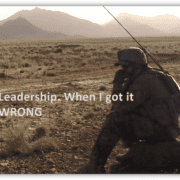During my time with the Australian Army, I learned a lot about strategy and tactics with regard to resource management.
History has shown that the outcome of almost every major military effort comes down to differences in strategic approach. Essentially, one approach works, and one fails. After I left the service and became a management consultant, I found this to be relatively similar in the corporate world. While organizations can co-exist in the same industry, their actions still affect one another, especially if they are locked in a contest for market share. In that contest, as in military action, one strategy will succeed, and one will not. Yet even with that knowledge, many company leaders refuse to change their strategy, often to their own detriment.
Conversely, those organizations that are willing to entertain new approaches often end up leaving their competitors in the dust. Regardless of size or industry, companies that seem to glide toward their goals are able to answer one fundamental question:
How do we best allocate our resources to achieve our goals?
When it comes to resource management, you can apply many different military methodologies to a corporate and commercial context.
Attrition Resource Management
Attrition warfare involves wearing down the enemy to the point of collapse. The World Wars were prime examples. During these campaigns, one side would bring as much force to bear on the enemy as possible until they fell apart.
Attrition warfare unequivocally favors the more significant force and requires less imagination and agility than other strategies. The resource cost is immense, but if conducted in the right context, it can result in decisive victories where the enemy is incapacitated in one fell swoop. However, if a decisive victory is not achieved, wars of attrition can drag on for years as each side becomes more entrenched and, therefore, more difficult to dislodge.
In the corporate context, examples of attrition warfare tactics as they related to resource management might include:
- Paying for premium ad space that may be unreachable for competitors (such as a Super Bowl commercial)
- Sponsoring major industry events
- Taking legal actions against competitors (such as copyright or trademark infringement lawsuits)
- Poaching high-end staff with the promise of better pay and benefits
Attrition as a practical commercial strategy is only practical for those with a large number of resources on hand. Corporations that already control a massive share of the market will do the best with attrition resource management as there is no practical way for smaller organizations to compete with them.
Maneuver Resource Management
Maneuver warfare is a strategy aimed at unbalancing or unhinging the enemy. It identifies the root purpose of the enemy campaign (such as taking control of a certain landmark) and finds different ways to do the same thing. Essentially, it targets an enemy’s “center of gravity,” or the ineffable “something” that gives them the will or the ability to fight.
Throughout the course of history, militaries have used maneuver warfare through the following avenues:
- Physical Dislocation: Removing the key assets or logistics that enable the enemy to operate.
- Temporal Dislocation: Moving faster when achieving important terrain, milestones, or assets.
- Moral Dislocation: Attacking the enemy’s will to fight. This often includes a significant effort to get into the minds of the key decision-makers and shape their decisions.
These methods can run simultaneously, and all of them emphasize the elements of surprise and speed.
For resource management, maneuver warfare shines brightest in organizations that are adept in prioritization and channeling their efforts towards the outcomes that will have maximum impact for minimum input. These organizations know their strengths and weaknesses inside and out and magnify their results exponentially by focusing their precious resources on two or three outcomes instead of a dozen.
Maneuver warfare for resource management not only allows medium-sized organizations to start capturing market share from bigger competitors, but it also ensures a more tailored market share.
Guerrilla Resource Management
The concept of guerrilla-style tactics was heavily publicized by Sun Tzu, who suggested in The Art of War that a small force could win against a much larger competitor if it made use of every available resource with the utmost haste.
Guerrilla warfare is based on the idea that smaller teams can create significant issues for their enemies providing they stay under the detection threshold. They almost always have few to no resources, and therefore rely heavily on unorthodox methods (such as ambushes, raids, or sabotage) and a loyal support network.
In the corporate or commercial context, smaller, more agile organizations can achieve proportionately huge impacts if they are agile, dynamic, and able to rally passionate support for their cause. It also means that smaller boutique agencies can provide highly tailored services to those with simpler, more focused needs.
In many ways, this approach to resource management has been one of the founding successes of The Eighth Mile Consulting. We endeavor to support areas of the market that remain undetected by the larger players in the industry. With support from partner organizations, we can seize opportunities quickly, provide valuable services, and maintain our support network.
In Conclusion
This might seem counter-intuitive given what’s been discussed thus far, but these resource management strategies do not have to be adopted in an overtly aggressive manner. They may be more useful at guiding your team’s operations than they are at destroying your competitors.
In addition to a competitive edge, consider what a resource management strategy can help you achieve:
- Prioritizing your efforts toward specific outcomes
- Focusing the scope of operations on what will be the most impactful
- Highlighting strengths and weaknesses
- Identifying paths of least resistance in the marketplace and promoting early action
- Incentivizing creating thinking instead of reinventing the wheel
As you can see, the real enemy is not your competitors, but the conditions in which you operate. Through proper and appropriate resource management, you arm yourself with the weapons you need to reinvent, endure, and ultimately succeed.
At The Eighth Mile, our organizational values and ethos are clear:
- Service: Client-tailored training
- Initiative: Find the needs and fill them
- Integrity: Deliver on every promise
- Accountability: Personal investment in every outcome
Manage and lead your team to victory through our 8-week online leadership courses or private consulting for unique business strategies. Get in touch with our team to discuss your company’s needs.



 The Eighth Mile Consulting
The Eighth Mile Consulting  The Eighth Mile Consulting
The Eighth Mile Consulting 
 The Eighth Mile Consulting
The Eighth Mile Consulting  The Eighth Mile Consulting
The Eighth Mile Consulting 
Trackbacks & Pingbacks
[…] in battle, rendering them vulnerable to attack. Maneuver warfare draws heavily on the principle of acting fast with available resources. It’s the concept from which the OODA loop […]
Leave a Reply
Want to join the discussion?Feel free to contribute!